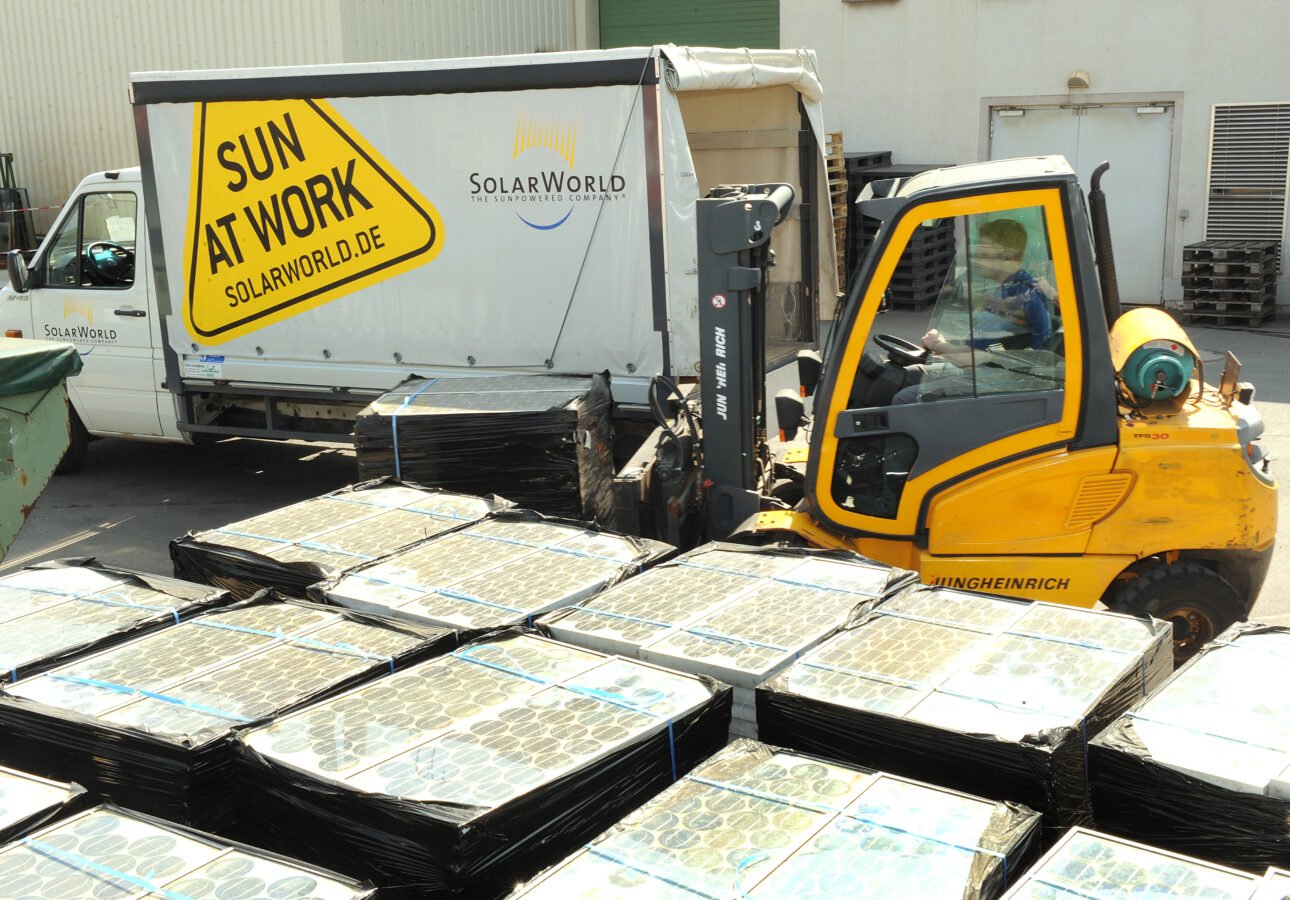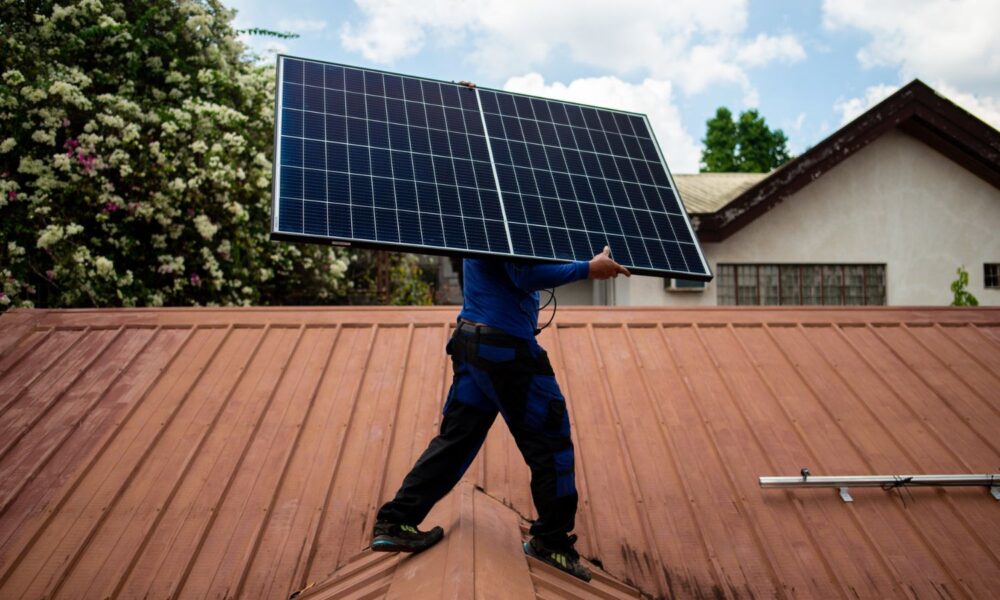Picture this: Light energy from the sun zooms through the solar system to reach your sunny rooftop, gets absorbed into your solar panel, and charges the device or computer on which you are reading this post. It is a perfectly closed, sustainable system. Can the life cycle of a solar panel itself be just as circular?
Today, unfortunately, the life cycle of a solar panel is not yet a “cycle.”
It is more like a straight line from silica mine, to refining factory, to shimmering batch of shining polysilicon ingots, to panel assembly, to a couple decades generating clean electricity—and then, far too often, to a landfill.
Only 10% of solar photovoltaic, or PV, panels are recycled today in the US, and the rest meet their inglorious end in the garbage heap. Among those that are recycled, very few have 100% of their material recovered. There is presently no federal law or regulation regarding residential or utility-scale solar panel reuse or end-of-life management.
But there is hopeful progress in state policy, business and research innovation, and nonprofit solutions. This post explores current case studies of responsible, sustainable end-of-life solutions, and makes recommendations for future circular solar supply chains.
Meet today’s end-of-life solar leaders
Several states have pioneered innovative public policy to recycle and repurpose retired residential and commercial solar panels. For example, the state of Washington requires photovoltaic module manufacturers either take back and reuse or recycle modules at no cost to owners. New Jersey has formed a commission to create recommendations for solar panel recycling, and North Carolina directed their Department of Environmental Quality to adopt rules for governing panels’ end-of-life management in utility-scale projects. Meanwhile, a California law reclassified PV modules as “universal waste” as opposed to “hazardous waste,” which involves less stringent handling regulations.
In the for-profit and nonprofit sectors, several companies and organizations lead the solar panel reuse and recycling transition. US company First Solar can recover 90% of its panel’s materials (which are cadmium telluride, not crystalline silicon). Good Sun is a nonprofit organization based in California that sells used solar panels for a discounted price for installation in low-income US communities. And Solarcycle aims to recycle up to 95% of panel materials, including the difficult-to-extract silver, copper, and silicon, via an electrostatic separations process that separates these particles by mass and electrical properties.


What solutions exist for a more circular end-of-life?
While promising legislation and private and nonprofit sector efforts are leading the way towards a more circular solar supply chain in the US, much more acceleration of reuse and recycling is needed. The myriad challenges involved in mining and manufacturing solar panels add to the reasons why the industry must increase its reuse and recycling of used panels. There are many paths forward for ensuring that the lifecycle of a solar panel is circular not linear. Here are two:
1. Use regulation to increase solar panel reuse.
Like driving a car more than 200,000 miles to its very last sputter, extending the life of a solar panel should be the first obvious solution. Solar panels should be used as long as possible. They do, however, lose some of their generating capacity over time.
An analysis by the Harvard Business Review predicts that those capacity decreases, along with cheaper and better panels coming on the market, may incentivize solar customers to discard their old panels early, and buy new ones. If too many consumers choose to get rid of their panels in 10-15 years as opposed to 30 years, discarded panels could outnumber new panels installed by 2.5 times in 2035, compounding the need for increased reuse solutions.
Early retired solar panels usually retain 70-90% of their original capacity. However, few solar manufacturers currently invest in the repairs to prepare panels for secondary life resale because repair costs often exceed resale profits. But there is a way through this problem.
The EU requires manufacturers to handle the reuse and recycling of solar panels with no cost to consumers. The US could create similar rules here. This would incentivize companies to provide additional refurbishing, life-extending services to their customers. Governments can also provide tax credits for companies providing robust repair and refurbishing services that extend client usage. To boost the secondary sale of good-condition solar panels for reuse, the US could also enact a nationwide standard that facilitates labeling and diagnostics of the quality of used PVs, so producers and buyers can better assess their price, value, and safety.
Manufacturers have a responsibility here, too; they can design panels with reuse in mind and facilitate parts disassembly and refurbishing for resale. States and the federal government can enact policies to reduce the regulatory burden and liability associated with reuse.
2. Boost the solar panel recycling industry.
Governments and the panel manufacturing industry can create a robust system for solar panel recycling. Effective solar panel recycling necessitates policy enactments at the state and federal levels and increasing the recycling market so that the cost of recycling per panel is less than the cost of sending it to a landfill.
According to the National Renewable Energy Laboratory (NREL), recycling a solar panel in the US can cost $15-45, while sending a panel to the landfill costs only $1-5. In the EU, on the other hand, recycling costs $0.75 per panel because of mandates requiring manufacturers pay into a fund that subsidizes recycling. Consequently, in the EU, solar recycling rates reach 95%.
Additionally, US consumers need more information from manufacturers on the cost and value of recycling and reusing their PV panels. Manufacturers and secondary buyers should have open access to reliable data on the cost-benefit of different end-of-life options.
The federal government has a role to play, too. It could invest in research to optimize cost-effective recycling that processes the majority of the solar panel.
Lastly, and crucially importantly, solar panels must be recycled safely, sustainably, and ethically, both in the US and abroad. Corporate commitment and government regulation can help ensure that the solar industry upholds stringent labor and environmental standards, as some general e-waste industry operations continue to endanger recycling worker health and safety.
The path forward
We all want the most sustainable, responsibly sourced solar panels on our rooftops and in our communities. Governments, businesses, and consumers are increasingly committed to achieving that goal. Supply chain and end-of-life challenges also present opportunities for better circular innovation and stewardship as we move into the clean energy future.
Want to learn more about how solar panels are made and the solar panel supply chain? Which countries are driving PV material mining and PV manufacturing? Click the links for answers:
Mining Raw Materials for Solar Panels: Problems and Solutions

